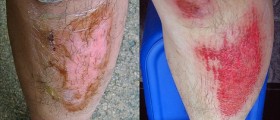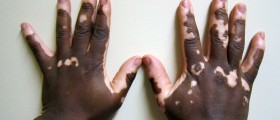
People of all ages and genders can face the problem of skin discoloration, which can itself appear in many forms and in numerous different places. Sometimes, the skin discoloration will appear in patches of varying sizes, and the skin will become dry and potentially flaky as well. The chances of having such problems are greater if the person’s skin is very fair, because discoloration, especially on the neck, will be very prominent.
If the skin discoloration is severe, meaning your skin is either greatly discolored or the affected patch is large, then it is best to contact a dermatologist immediately for proper diagnosis and treatment. However, if the discoloration of the neck is not that serious, then there are home remedies that can potentially help a person get rid of it. Finally, if the affected area is additionally painful, skin discoloration should not be taken lightly and treated without a consultation with a medical expert, as it is essential that the underlying cause be identified.
Neck Discoloration is a Common Problem
There are many possible reasons behind a skin discoloration affecting the neck area. Exposure to the sun is a common culprit that leads to hyperpigmentation, making the skin on the neck brown and darker. This happens due to an overproduction of a skin pigment called melanin. When melanin reacts to sunlight, this results in discoloration.
An overdose of iron will also change the color of the skin. Additionally, when there is an excess amount of fat in the body, the skin of the neck can fold over and discoloration can develop within these folds of skin. Obesity is, therefore, another common reason for discoloration of the skin.
Certain medicines may lead to discoloration of the skin, especially those drugs that affect the hormonal balance of the body. For instance, contraceptive pills are known to cause skin discoloration in some users.
Aging is another reason behind a variety of skin changes including skin discoloration. This is often due to a whole slew of problems that come with getting old, some of which affect the skin and change its appearance.
Thankfully, there are simple home remedies that can be used to take care of skin discoloration on the neck and elsewhere. However, it is important not to be impatient and give up on the remedy after a short period of time, because some of these remedies take a longer amount of time to begin working.
Before trying any of the remedies that may help you with skin discoloration on the neck, it is important to clean the neck and other affected areas with mild soap and wipe them dry. Lemon juice can be used as a home remedy for darker discolorations, as it acts as a type of natural "bleach" and will brighten the skin. Apply the juice to the affected parts and let it sit there for about half an hour before rinsing it off. Be aware, however, that this can also have a drying effect on the skin.
Olive oil is another effective home remedy for some cases of skin discoloration. Apply it to the affected skin and then rub the skin gently. In time, the discoloration may fade away, as the skin becomes moisturized more adequately.
It is almost always best to consult a doctor before trying any of the home remedies other people may recommend to you, and check whether there is an underlying condition associated with skin discoloration on the neck that requires medical treatment or prescription drugs. While olive oil and lemon juice are not going to be dangerous, the fact that you are using them may mean you are avoiding seeing a doctor, and thus don't have access to potentially more effective treatments.
What to do if your Skin is Painful to Touch?
Even though a variety of health conditions and factors may contribute to pain in different parts of our body, skin that is painful to touch is a reason to worry because it never occurs without being caused by some underlying medical issue or injury. By causing a painful sensation, our skin (or rather the nociceptors, the receptors responsible for emitting pain signals, within) "wants" to warn us that there is some imbalance in our body which requires prompt correction.
Sore skin can be associated with a lack of some essential vitamins. So, by using vitamin supplements and consuming food rich in the deficient vitamin, it is sometimes possible to put a stop to sore skin you are experiencing. If you are not sure whether you are deficient in any vitamins or minerals, get tested.
Furthermore, skin painful to touch is a common clinical characteristic of almost every dermatological disease. Many skin diseases are culprits of painful skin and once they are treated properly, the pain in the area soon subsides.
It is also possible to experience painful skin to touch if there is some systemic illness. For instance, diabetes is known to cause an imbalance of sugar in the body, that is, diabetes is responsible for an increase in the level of sugar in the blood. One of the more common complications of this disease is peripheral neuropathy. If certain nerves innervating the skin are affected, the skin area innervated by these damaged parts of the nervous system becomes way too sensitive to touch. Such patients simply cannot benefit from insulin therapy which is necessary to control the level of glucose in the body. They require additional medications to deal with unpleasant sensation that will never go away on its own.
Fibromyalgia, a central pain disorder, is another condition frequently blamed for painful skin to touch. It requires a complex approach and treatment because its underlying cause has not been fully identified yet. In people suffering from migraines, the head is the primary source of pain. They, however, may additionally complain about painful skin of the temples or the forehead, especially in the middle of a migraine attack. Medications that treat migraines also take care of this additional health problem.
Finally, exposure to excessive heat or cold can trigger painful skin to touch; something you will probably be familiar with. Our body cannot tolerate extremely high or low temperatures for very long. These extreme temperatures may cause damage to the superficial nerves and initiate a painful sensation. This unpleasant sensation usually withdraws on its own, unless extreme temperatures have caused more complex damage to the skin such as burn or frostbite, both of which require emergency medical care.

















Your thoughts on this
Loading...